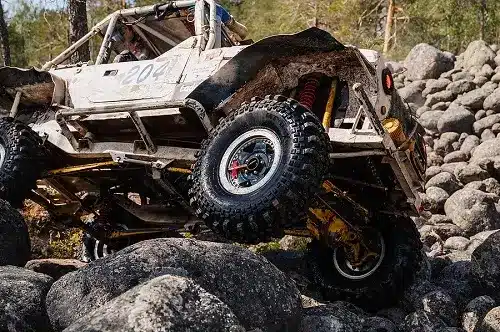Off-Road Axles: What You Need to Know

It provides ground clearance while being versatile for various driving conditions. And one part of this system is the off-road axle.
At Outlander Motorsports in Martinez, CA, we offer a full array of off-roading products and services to improve your ability to go further. As experts in off-roading customization, we are often asked about off-road axles, which we’ll discuss in this post.
Axle and Articulation
An axle is a rod or shaft connecting a pair of wheels. It is the heart of any off-road suspension setup of a 4WD truck or SUV. As such, any suspension system must work to accommodate the axle design.
It’s vital that the off-road axle must be able to articulate over terrain. Articulation is the ability of one wheel to move up and down relative to the wheel on the opposite side.
If you’re looking to climb that rock or overcome obstacles, you must always have traction. As fun as it is to see one wheel leaving the ground when mastering rugged terrain, this can be dangerous every time traction is wholly lost.
And this explains the pivotal role of off-road axles.
Types of Off-road Axle
Most vehicles operate in either a 4×2 or 4×4 mode.
With the two-wheel variety, only one axle—front or rear— will receive 100% of the torque. On the other hand, 4×4 means the vehicle delivers torque to both front and rear axles in one of several different ratios.
As you can see, an off-road axle—also referred to as a 4WD axle—will deliver more functionality and capability to help you power over rugged terrain.
Generally, there are two types of 4WD axles: solid and independent.
Solid 4WD Axle
The solid axle is also called a beam or live axle. This explains why both wheels are connected to one axle housing that extends the length of the vehicle.
This axle physically connects both wheels to the same housing, which makes it a dependent suspension. One wheel moving down or up will directly impact the wheel on the other side of the vehicle.
A solid axle can help bolster traction over hills and big bumps while gaining more torque from the differential. This is because there are fewer parts the power must move through.
Solid axles are generally more dependable and durable than independent front suspension axles. They can also be easily changed, making repairs easier.
Independent Axle
When independent suspensions are discussed, you will often hear about wishbone suspensions. This is because of the design of the lower and upper control arms.
As you would guess, an independent axle is often used with independent suspension. The axle housing sits at the center of an independent assembly, where the carrier and ring gear are stored.
This design uses constant velocity (CV) axles instead of axle tubes extending out to the wheels.
The CV axles refer to the transference of the engine power at a continuous rotational speed—regardless of the turning angle. This setup allows the wheels to move down and up without affecting one another.
Contact Outlander Motorsports in Martinez, CA for Off-Road Axles and 4x4 Upgrades
At Outlander Motorsports, we specialize in all things 4×4 trucks and SUVs. We are the trusted shop for all off-road modifications, including axles and suspensions. Our mechanics also educate and help customers make the best decisions for their off-roading vehicles.
Want to learn more? Call us at (925) 839-4144. Or stop by our shop at 1424 Shell Ave, Suite D, Martinez, CA 94553.